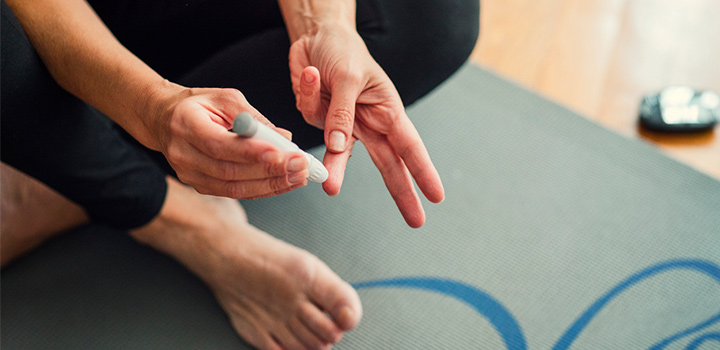Diabetes and exercise: how, what, when and why

If you're diabetic (or nearing it), you've no doubt heard that regular exercise can reduce your risk. If you're not sure what it entails, here are answers for all your FAQS about exercise!
Exercise is one of the three pillars of diabetes management, together with medication and a healthy diet. If you're wondering why, here's the long and the short of it.
Why should I exercise?
Exercise for type 1 diabetes increases insulin sensitivity (which means your body will require less insulin). It helps for type 2 by lowering body fat and increasing insulin production. Exercise also helps prevent foot ulcers, as physical movement improves blood flow to blood vessels that take oxygen and nutrition to muscles and tissue.
How much exercise do I need?
For the best health benefits, at least 150 minutes (2.5 hours) a week of moderately intense physical activity is recommended, such as fast walking, lap swimming or cycling. Include muscle-strengthening activity twice a week.
How hard should I exercise?
Aim for moderately intense exercise and clear your readiness for highly intense exercise with a healthcare professional first. Moderate-intensity activity raises the heart rate. Breathing becomes faster and temperature increases, but talking easily is still possible. Vigorous-intensity activity raises the heart rate significantly and breathing becomes hard and fast. No more than a few words can be spoken without pausing for a breath.
Why is the timing of my session so important?
Always consider the timing of exercise and how it impacts medicine levels. To exercise safely, it’s crucial for diabetics to track their blood sugar before, during and after physical activity.
This is especially the case if you're taking insulin or medicine that can cause low blood sugar (hypoglycaemia), as exercise draws on reserve sugar stored in the muscles and liver. As the body rebuilds these stores, it takes sugar from the blood.
How do I track my blood sugar when I exercise?
If you're diabetic, you must get your doctor's approval before you start an exercise plan, especially if you have been inactive. Here are some guidelines to keep in mind:
- The more strenuous the workout, the longer blood sugar will be affected - even up to 4 to 8 hours after exercise. A slow-acting carbohydrate snack after a workout, such as nuts or trail mix, can help prevent a drop in blood sugar.
- Before exercising, the urine should also be tested for ketones - substances made when the body breaks down fat for energy. The presence of ketones indicates that the body doesn’t have enough insulin to control blood sugar.
- Exercising with high levels of ketones may cause ketoacidosis, a serious complication of diabetes that needs immediate treatment.
- Only continue exercise once your high blood sugar levels are corrected. Check your blood sugar every 30 minutes, especially if the duration or intensity of the workout is increased.
- Stop exercising if your blood sugar is 3.9 mmol/L (70 mg/dL) or lower.
- Eating or drinking something with 15 g to 20 g of fast-acting carbohydrate will raise blood sugar levels again.
- Recheck your blood sugar 15 minutes after the snack, and if still too low, eat another 15 g of carbohydrate. Repeat this process until your blood sugar reaches at least 70 mg/dL (3.9 mmol/L).
How do I become more active?
It's clear that exercise is a great way to lower blood glucose levels, improve insulin resistance and shed weight. Here are a few ideas to get you going:
- Start slowly by making small changes to current activity levels. Find ways to bring more movement into your day, like taking the stairs and walking more. Increase your activity bit by bit, tracking it all the way.
- Set (realistic) goals. Variety is key. Choose an activity you enjoy to encourage regular participation - be it a walk or swim, a sports team practice, a martial art or dance.
- Make it social. Join your local parkrun on www.parkrun.co.za and enjoy the outdoors at a brisk pace with your friends and family.
Track your health with a fitness device
There's no shortage of health and fitness devices on offer that can help monitor all kinds of health data to keep you on track. Get up to 25% off a wide range of devices with Vitality's HealthyGear or HealthyCare benefits, and link your device to Vitality so you can earn fitness points on the go.
But there's more - soon you can get up to 75% cash back on a new fitness device with the Vitality Active Rewards Device Booster benefit, which launches next year. So sign up and get tech-savvy to start improving your health!
Find the motivation to manage diabetes with DiabetesCare
Managing diabetes can be tricky, but it's well worth it, given how much you do so can improve your quality of life. To help, we've put together a well-coordinated programme that integrates Discovery Health's clinical tools and networks with Vitality's preventive screening and incentive structures.
Get a new lease on life - learn more about DiabetesCare today!
Related articles
Your diabetes dictionary: A guide to understanding medical jargon
Do you zone out when someone starts using medical jargon? Here are some simple explanations so you can keep yourself in the know with diabetes terminology.
A mom's guide to gestational diabetes
Gestational diabetes can come as a shock to women who've never had any issues with their blood sugar levels before. Here's what expecting parents need to know.
Get ready to run - a beginner's guide
Busy? We understand. Haven't exercised in a while? Don't worry - starting running (and sticking with it) is easier than you think. But first things first: you need to get your body and your mind prepared for running.